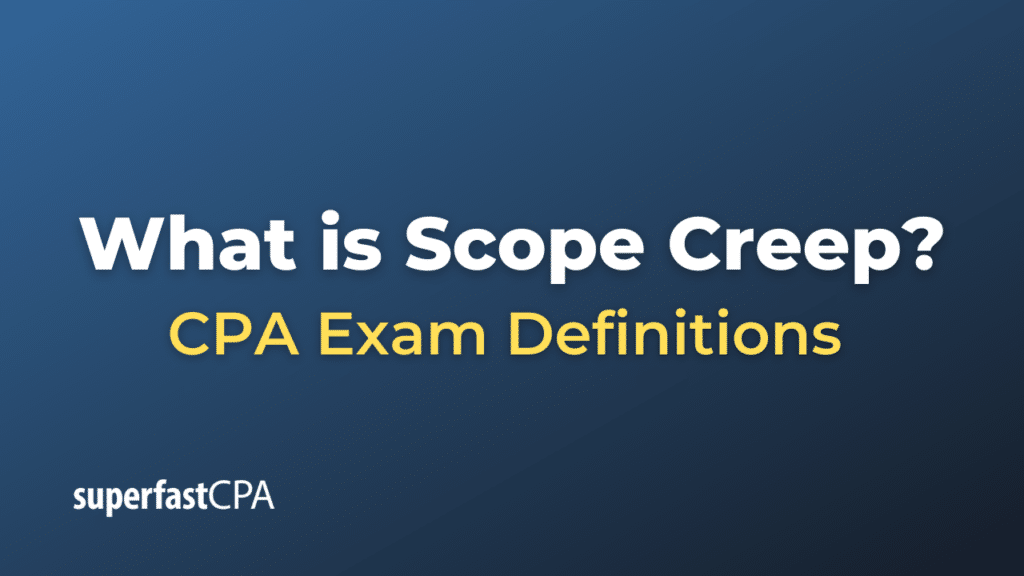Scope Creep
Scope creep refers to the uncontrolled changes or continuous growth in a project’s scope after the project has started, without corresponding increases in resources, time, or budget. This phenomenon can occur when the scope of a project is not accurately defined, documented, or controlled. If not addressed, scope creep can lead to projects going over budget, missing deadlines, and even complete failure to deliver the project’s original objectives.
Causes of scope creep include:
- Vague Objectives: Lack of clarity in the project’s initial goals or objectives can make it easy for new requirements to be added later.
- Lack of a Clear Change Process: If there’s no established process for handling changes or additions to a project, it becomes easier for the scope to expand uncontrollably.
- Stakeholder Pressure: Different stakeholders might have varying visions for a project. They might continuously request changes or additions based on their individual preferences or evolving ideas.
- Over-Eagerness to Please: Sometimes project teams or managers might agree to changes in a bid to please stakeholders, even if those changes aren’t accompanied by adjustments in resources or timelines.
- Poor Communication: Miscommunication or lack of communication between stakeholders, team members, and clients can result in differing expectations and last-minute changes.
Addressing scope creep involves:
- Clear Documentation: Clearly document the project scope, objectives, and deliverables at the outset.
- Change Management Process: Have a well-defined process for handling any requested changes to the project. This might involve evaluating the impact of the change, obtaining necessary approvals, and adjusting resources or timelines as needed.
- Regular Reviews: Conduct regular project reviews to ensure that the project remains on track and adheres to the defined scope.
- Stakeholder Management: Ensure that all stakeholders are aligned in their expectations and understand the implications of changes.
- Clear Communication: Maintain open communication channels among all parties involved to ensure that any changes are clearly understood and agreed upon.
- Educate the Team: Ensure that everyone involved understands the risks associated with scope creep and the importance of adhering to the project’s defined scope.
In essence, while changes in projects are sometimes inevitable, managing those changes effectively and ensuring they don’t lead to uncontrolled growth in project scope is crucial for project success.
Example of Scope Creep
Let’s use the development of a new mobile application as an example to illustrate scope creep.
Scenario: Developing “FitLife” Fitness App
Original Project Scope:
- Objectives: Create a mobile app that allows users to track daily workouts and calorie intake.
- Features:
- A workout log where users can input exercises, sets, reps, and weights.
- A food diary for tracking meals, with a database of common foods and their calorie counts.
- Basic reporting features, such as weekly workout and calorie summaries.
- Timeline: 4 months
- Budget: $50,000
As the project progresses, the following changes are proposed:
- Stakeholder Suggestion: “Can we also include a feature that tracks the user’s steps and distance walked or run?”
- Client Feedback: “I recently used a meditation app. Can we add a meditation timer and some guided meditation audio tracks to our app?”
- Developer Idea: “It would be cool if we integrated with smart scales to automatically import user weight and body fat percentage.”
- End-user Feedback from Beta Test: “It would be great to have a social feature to connect with friends and see their workout logs for motivation.”
While each of these ideas could enhance the app, they were not part of the initial scope. Integrating them without adjusting the timeline or budget could lead to the following issues:
- Overstretched Resources: The development team might be overwhelmed with the new features, potentially leading to burnout or mistakes.
- Delayed Timeline: The added features could push the launch date further out, disappointing users and stakeholders awaiting the app’s release.
- Increased Costs: More features could mean more development, testing, and potential licensing costs (e.g., for the guided meditation tracks), leading to a budget overrun.
- Potential Quality Drops: Hurrying to implement new features could compromise the quality of the original features, leading to bugs or a less-than-ideal user experience.
If the project manager had accepted all the changes without a clear change management process, this would be a classic case of scope creep. The solution would be to evaluate each proposed change against the project’s goals, budget, and timeline, prioritize them, and make necessary adjustments, if accepted.
In reality, this kind of scope expansion is common, especially in software development, where iterative feedback can lead to new ideas and desired functionalities. The key is to manage these changes effectively to ensure the project remains feasible and successful.












